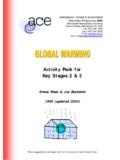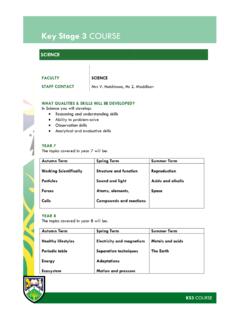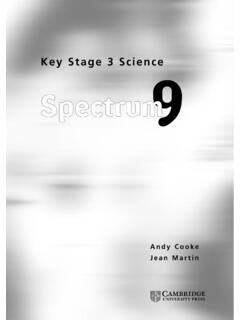Transcription of Teaching Pack for Key Stages 3, 4 & A-Level
1 ACE is supported by the Department for Environment, Food & Rural Affairs Atmosphere, Climate & Environment Information Programme, aric Manchester Metropolitan University Chester Street, Manchester M1 5GD Tel: 0161 247 1590 Fax: 0161 247 6332 E-Mail: Internet: Teaching Pack for Key Stages 3, 4 & A-Level Sue Hare 1999 (updated 2002) ACE Information Programme aricUrban Air Quality Teaching Pack: KS4 & A2 Lesson History of Urban Air PollutionLesson Patterns of Urban Air PollutionLesson Air Pollution in the 1990sLesson 4. Transport and Urban Air PollutionLesson and Urban Air PollutionLesson Effects of Urban Air PollutionLesson to Urban Air PollutionGlossaryReferences & Further InformationOHPsACE Information Programme aricUrban Air Quality Teaching Pack: KS4 & A3 AIM:To highlight and investigate the quality of urban air in the :To increase awareness and understanding of the sources andeffects of the main urban pollutants and to identify possibleresponses to improve air AUDIENCE.
2 Teachers of students aged 12 - 18 years studying geography,science and environmental studies/ science for Key Stages 3 to 4 ofthe National Curriculum (GCSE), and ENHANCEMENT:Students will develop an awareness and understanding of thecurrent environmental issue of air quality in urban areas. Thehistorical perspective and changes in air quality to the present daywill be appreciated through the use of this pack. Students will alsogain an up to date appreciation of air quality in urban areas, and theimportance of the contribution of vehicular pollution in particular as amajor source of urban air pollution today.
3 Students will also increasetheir knowledge and understanding of the effects of urban airpollution and gain an insight into the responses that can be taken toimprove the quality of air in towns and cities of the Information Programme aricUrban Air Quality Teaching Pack: KS4 & A4 THE USE OF THIS PACK: Teachers are strongly encouraged to read this pack thoroughlybefore embarking upon its use. Students will gain maximum benefit if all of the lessons arecovered in the order set out in this pack. However, lessons maybe used in isolation if Teaching time does not permit, or if certainlessons prove relevant for a particular syllabus.
4 The optional exercises at the end of each lesson are designedto aid students in understanding the topic covered in eachsection. Usually the exercises require students to draw oninformation supplied with each lesson topic, or to investigate theissue by their own personal research. These exercises may bemost useful for key stage 3 & 4 students. Sheets for photocopying as OHPs have been included at theend of the pack to help teachers convey factual and graphicalinformation to their Information Programme aricUrban Air Quality Teaching Pack: KS4 & A5A Brief Summary of Air Pollution HistoryUrban air pollution is certainly not a new problem.
5 Back in the daysof the Middle Ages the use of coal in cities such as London wasbeginning to escalate. By the end of the 16th century the problemsof urban air pollution are well Industrial Revolution in the 18th and 19th centuries was basedon the use of coal. Industries were often located in towns and cities,and together with the burning of coal in homes for domestic heat,urban air pollution levels often reached devastating levels. Duringfoggy conditions, pollution levels escalated and urban smogs(smoke and fog) were formed.
6 These often brought cities to a halt,disrupting traffic but more dangerously causing death rates todramatically rise. The effects of this pollution on buildings andvegetation also became obvious. The 1875 Public Health Actcontained a smoke abatement section to try and reduce smokepollution in urban 1926 Smoke Abatement Act was aimed at reducing smokeemissions from industrial sources, but the remaining problem thatwas not being tackled was pollution from domestic Great London Smog of 1952 which resulted in around 4,000extra deaths in the city, led to the introduction of the Clean Air Actsof 1956 and 1968.
7 These introduced smokeless zones in urbanareas, with a tall chimney policy to help disperse industrial airpollutants away from built up areas into the Information Programme aricUrban Air Quality Teaching Pack: KS4 & A6 Following the Clean Air Acts, air quality improvements continuedthroughout the 1970s and further regulations were required throughthe 1974 Control of Air Pollution Act. This included regulations forthe composition of motor fuel and limits for the sulphur content ofindustrial fuel , during the 1980s the number of motor vehicles in urbanareas steadily increased and air quality problems associated withmotor vehicles became more prevalent.
8 In the early 1980s, the maininterest was the effects of lead pollution on human health, but by thelate 1980s and early 1990s, the effects of other motor vehiclepollutants became a major concern. The 1990s have seen theoccurrence of wintertime and summertime smogs. These are notcaused by smoke and sulphur dioxide pollution but by chemicalreactions occurring between motor vehicle pollutants and are known as photochemical smogs .Key Dates for the History of Air Pollution in the UKThe following key dates identify some of the major facts relating tourban air pollution in the UK over recent British scientists John Evelyn & John Graunt found that pollutedair from industry could affect vegetation and people.
9 Theysuggested that industries be located in the countryside tominimise effects on Robert Angus Smith identifies acid rain in Robert Angus Smith became the first air pollution inspector The Public Health Act. This contained a smoke abatementsection; legislation to the present day has been based on Information Programme aric Urban Air Quality Teaching Pack: KS4 & A 7 1890 Sulphurous smogs had been reported for over 100 years in many British cities. Smog became the term to describe severe air pollution conditions, derived from a combination of smoke and fog.
10 1926 Public Health (Smoke Abatement) Act. This amended and extended the previous Public Health Acts of 1875 and 1891. 1930/1 Additional deaths occurred in a smog in Manchester & Salford. This began a campaign which ultimately led to the introduction of smoke control. 1952 The famous London Smog occurred in December 1952 and resulted in thousands of premature deaths. 1956 & 1968 Clean Air Acts. These had a dramatic effect on air quality and eliminated the occurrence of the types of smogs of previous decades. 1974 Control of Pollution Act.










